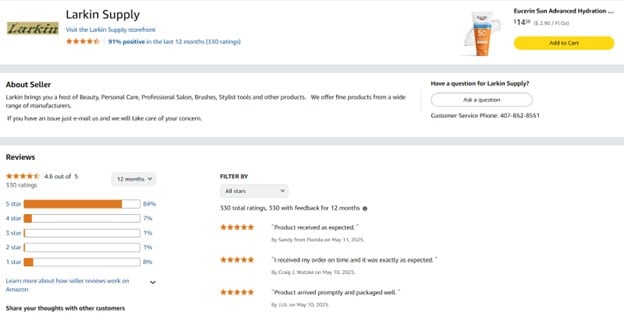Amazon seller feedback is a crucial tool to build customer trust, improve your ratings and stand out from competitors.
Ecommerce companies understand that customers demand the best service. 86% of buyers are even willing to pay more for a better experience.
Since customers spend time researching different companies, Amazon is willing to make it easier for them. For example, Amazon publicizes seller feedback so new customers can read existing experiences before purchasing anything.
Offering the best customer experience is essential for an ecommerce company to build trust and stand out from competitors. These efforts will result in increased sales.
What can ecommerce companies do to improve their customer experiences? Continue reading to discover how to boost your Amazon seller feedback.
What is Amazon Seller Feedback?
Amazon seller feedback encompasses all critical components of the buying experience. This includes everything about the product listing, the seller’s Amazon shop, and fulfillment, specifically shipping and packaging.
How Amazon Seller Feedback Works
Like a product review, customers can leave a rating on their order or the seller feedback page. Customers can access the seller’s page on the product listing. Underneath the option to purchase the item, customers can see the company under “Sold By” and click the name.
Amazon will ask preset questions about the shopping and fulfillment process, and buyers will answer them with a rating between 1 and 5 stars. Customers can share specific experiences and criticisms at the end of the questionnaire.
Like product reviews, seller feedback will be displayed publicly on the store, and companies can view their overall score on their Seller Central Page.

Why is Amazon Seller Feedback Important?
Seller feedback is essential for different reasons. A high score boosts trust among your consumers and is also a crucial way for Amazon to evaluate sellers.
There are specific reasons why all brands should care about Amazon seller feedback. Let’s take a look:
Selling Privileges
If your seller feedback score is high, businesses will have more opportunities. But if your score is low, sellers will receive a warning. All sellers should aim to keep their negative feedback score below 5%.
1-star and 2-star ratings will decrease this score, and 4-star and 5-star reviews will increase it. 3-star reviews are neutral, but these can drag your score down if you have too many.
Win the Buy Box
Positive seller feedback increases your chances of winning the Buy Box. Since competition is so fierce, Amazon prioritizes sellers with the best customer experiences.
When it comes to the Buy Box, sellers shouldn’t focus as much on overall rating but on positive reviews. Amazon puts more focus on your reviews from the past 90 days and other selling factors, such as your price. Brands will also lose points when they get negative ratings.
Seller Feedback vs Customer Reviews
We mentioned that Amazon seller feedback differs from customer reviews. There’s one main reason: customer reviews are ratings on product quality, while seller feedback encompasses selling and fulfillment.
That said, there are similarities between the two. Both require verified reviews and offer insight into product quality and the customer experience. Amazon tracks both to ensure sellers are excelling and are worth promoting.
It’s easy to confuse the two, but what’s important is that you have good customer reviews and seller feedback. Focus on selling the highest-quality products and creating the best customer experience.
How to Change Seller Feedback on Amazon
No seller wants to get negative feedback, but it won’t disappear if you ignore it. Fortunately, there are a couple of best practices to deal with negative reviews.
Contact the Customer
The easiest way to address negative feedback is to contact the customer directly. On the rating, you’ll see an option to respond. You can either contact the customer over Amazon’s messaging system or by email.
When contacting the customer, focus on investigating what went wrong and how you can solve their problem. Offer a solution and see if the customer will accept.
Even if you solve the issue, the customer doesn’t need to remove their negative rating, or they can choose not to accept your solution. Contacting the customer isn’t an immediate fix, but it can help boost trust and possibly get another sale from them in the future.
Remove the Review
Can Amazon sellers remove negative feedback? You can if it violates Amazon guidelines. Some of the most common reasons why sellers may request review removal include:
- Contains promotional content for a competitor
- The feedback is for your product and not your selling performance (and vice-versa for product reviews)
- Contains obscene language
- Includes personal information
- Any FBA issues, such as shipping damage or receiving the wrong item
If you’re unsure if a review violates these guidelines, you can always use Amazon Review Checker to ensure spammers aren’t leaving fake reviews.
To remove a review, go to the Performance tab in Seller Central. After a few days, Amazon should follow up and remove the review.

Strategies to Improve Amazon Seller Feedback
Proactively running your Amazon business is the best way to achieve a positive seller feedback score. Here are some tips for keeping customers happy:
Offer Quick Shipping
If you don’t have FBA, offer the best and fastest shipping solutions. 2 in 5 buyers deal with delivery delays, and if your ETA is longer than expected, a potential customer will abandon their cart.
While FBA guarantees the best shipping, this isn’t always the best option for every seller. Ecommerce businesses can work with a 3PL company to offer quick and affordable shipping.
Provide the Best Customer Service
Exceptional customer service is the best way to boost positive seller feedback and product reviews. This includes communicating with customers about their orders, responding to inquiries, and handling complaints.
Mistakes happen, and many issues are out of your control, especially fulfillment problems. But if you notify buyers in advance, they will appreciate the heads-up and be less likely to leave negative feedback.
Create High-Quality Product Listings
Even if you sell on FBA, you may still receive seller feedback on your product listings. For example, if your descriptions and features don’t match the product, you will decrease trust among current and potential customers.
Write high-quality product descriptions and include as many details as possible, such as instructions, specifications, and features. If your customers are confused about anything, they can return to the listing and get the answers they need.
Keep up With Inventory
Negative feedback comes with low product stock, shipping delays, and fulfillment issues. An easy way to prevent these problems is by tracking your inventory.
Always ensure you have enough stock, especially during marketing and advertising campaigns. The last thing you want is to get healthy sales but have no product to fulfill all your orders.
Ask for Feedback
Sellers can’t bribe customers for a review, but can request feedback from customers. There are many ways to encourage customers to leave a review. For example, many sellers leave a note in the packaging.
If customers agree to email promotions, you can send them reminders to give you a rating.
Get the Best Amazon Seller Feedback
Customers will only support your business if they can get the best service. This is why Amazon seller feedback is one of the most critical factors in running a successful business.
Since Amazon asks for ratings on all aspects of the selling and fulfillment process, getting positive feedback can be challenging.Fortunately, we can help.
Our Accelerator service includes marketing, advertising, product listing optimization, and more. We tailor our services to individual sellers to ensure you accomplish your goals and get positive feedback.
Author
 Stephanie Jensen has been writing ecommerce content for seven years, and her copy has helped numerous stores rank on Amazon. Follow her on LinkedIn for more insight into freelance writing and creating high-quality content.
Stephanie Jensen has been writing ecommerce content for seven years, and her copy has helped numerous stores rank on Amazon. Follow her on LinkedIn for more insight into freelance writing and creating high-quality content.




